Stone-curlew facts for kids
Quick facts for kids Stone-curlews |
|
|---|---|
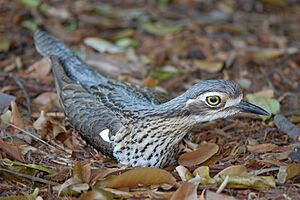 |
|
| Bush stone-curlew, Burhinus grallarius | |
| Scientific classification |
|
| Kingdom: | Animalia |
| Phylum: | Chordata |
| Class: | Aves |
| Order: | Charadriiformes |
| Suborder: | Chionidi |
| Family: | Burhinidae Mathews, 1912 |
| Genera | |
|
|
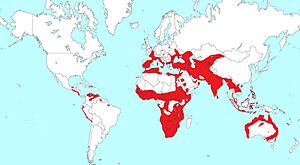 |
|
| modern range | |
The stone-curlews are a group of birds also known as dikkops or thick-knees. There are 10 different types, or species, in their family called Burhinidae. You can find these birds in warm, tropical places and also in cooler, temperate parts of the world. They live in many areas of Africa, Asia, and Australia.
Even though stone-curlews are classified as "waders" (birds that usually live near water), most of them actually prefer dry or semi-dry places.
Contents
What Are Stone-Curlews?
Stone-curlews are medium to large-sized birds. They have strong bills that can be black or yellow and black. One of their most noticeable features is their large, yellow eyes, which can make them look a bit like reptiles! Their feathers have patterns that help them blend in with their surroundings, making them hard to spot.
Why Are They Called Thick-knees?
The name "thick-knee" comes from the way their long, yellow or greenish legs look. They have very noticeable joints that look like thick knees. However, what looks like a knee is actually their ankle! The name "stone-curlew" comes from their general similarity to another group of birds called "true curlews."
Where Do Stone-Curlews Come From?
The family of stone-curlews, Burhinidae, was first named in 1912 by an Australian bird expert named Gregory Mathews. This family includes three main groups, or genera: Hesperoburhinus, Burhinus, and Esacus.
The name Burhinus is a mix of two old Greek words: bous, meaning "ox," and rhis (or rhinos), meaning "nose" or "bill." This might refer to their strong bills. It's important to know that stone-curlews are not closely related to the "true curlews" that belong to the sandpiper family.
Stone-Curlew Behavior
Stone-curlews are mostly active at night. This is especially true when they sing their loud, wailing songs. These songs can sound a lot like the calls of true curlews.
What Do Stone-Curlews Eat?
Their main food is insects and other small creatures without backbones, like worms. Larger types of stone-curlews might also eat lizards and even small mammals.
Migration Habits
Most stone-curlew species stay in one place all year. However, the Eurasian stone-curlew is different. It travels, or migrates, during the summer from its home in Europe to warmer places in Africa for the winter.
Types of Stone-Curlews
The oldest known stone-curlew fossil is called Genucrassum bransatensis. It was found in France and dates back to the Late Oligocene period. Here are the living species of stone-curlews:
| Picture | Name | Binomial name |
|---|---|---|
 |
Double-striped thick-knee | Hesperoburhinus bistriatus |
 |
Peruvian thick-knee | Hesperoburhinus superciliaris |
 |
Eurasian stone-curlew | Burhinus oedicnemus |
 |
Indian stone-curlew | Burhinus indicus |
 |
Senegal thick-knee | Burhinus senegalensis |
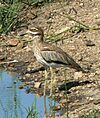 |
Water thick-knee | Burhinus vermiculatus |
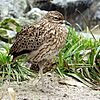 |
Spotted thick-knee | Burhinus capensis |
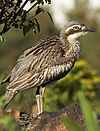 |
Bush stone-curlew | Burhinus grallarius (formerly B. magnirostris). |
 |
Great stone-curlew | Esacus recurvirostris |
 |
Beach stone-curlew | Esacus magnirostris |

